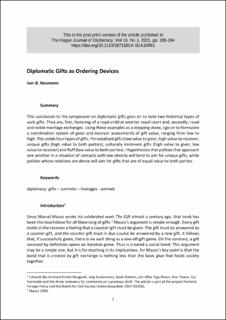| dc.description.abstract | This conclusion to the symposium on diplomatic gifts goes on to note two historical types of such gifts. They are, first, fostering of a royal child at another royal court and, secondly, royal and noble marriage exchanges. Using these examples as a stepping stone, I go on to formulate a coordination system of giver and receiver assessments of gift value, ranging from low to high. This yields four types of gifts. Personalised gifts (low value to giver, high value to receiver; unique gifts (high value to both parties), culturally irrelevant gifts (high value to giver, low value to receiver) and fluff (low value to both parties). I hypothesise that polities that approach one another in a situation of contacts with low density will tend to aim for unique gifts, while polities whose relations are dense will aim for gifts that are of equal value to both parties. | |
